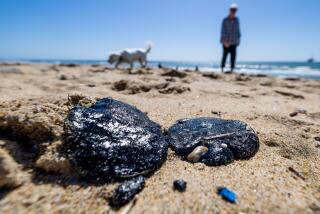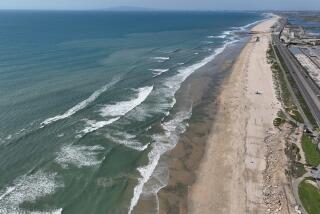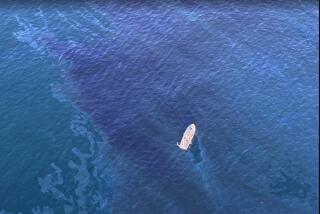Oil Skimmers Plow a Sea of Contamination
Like tractors tilling a vast field, a pair of skimmer boats plowing through the subdued waters off Huntington Beach on Thursday represented what officials believed was the best hope of conquering the American Trader oil spill.
But the boats were painfully slow, moving at only about 2 m.p.h. with their oil suction booms deployed. And their oil collection capacity was limited to about 1,200 barrels. They appeared as specks amid the miles-long spill from the breached oil tanker.
The two large skimmer vessels, converted from crew boats that serve offshore oil drilling platforms, were being supplemented by two smaller skimmers. In addition, the Coast Guard reported that three other private oil skimming vessels and 15 Navy skimmers were en route.
The boats formed the main vanguard in the war to fight the oil spill. The troops--about 400 shovel-armed beach cleaners--were awaiting their call.
“Right here in this area we have some of the biggest assets . . . and cleanup effort equipment in the world,” said Adm. Paul Yost, the Coast Guard’s commandant. “I’ve never seen an oil spill where you have this kind of response in less than 24 hours.”
Nature also was aiding in the effort. Mild weather and seas aided the sea skimmers, and the Coast Guard estimated that 30% of the oil would simply evaporate.
To a large extent, the Coast Guard sat back and watched the action. Coast Guard officials said that while they were deeply involved in monitoring and strategy, they would only take charge if the oil company efforts prove inadequate.
Just what is considered adequate appeared to depend largely on the available resources. Some observers, such as city officials in Long Beach, said they believe there isn’t enough cleanup equipment available to handle a major spill.
“We decided if we had to handle a disaster the size of the (Exxon) Valdez, it couldn’t be done with the amount of equipment on hand,” said Long Beach Assistant City Manager John Shirey, who took part in city hearings on the issue last year.
The initial response to Wednesday’s spill came within moments but fell woefully short, some officials said. A boat that routinely accompanies tankers to their moorings off Huntington Beach tried to boom off the ship, but Coast Guard officials said it did not have enough floating plastic skirt to encircle the American Trader and a trail of oil escaped into the ocean.
In about an hour after notification, the first cleanup boats of Clean Coastal Waters, a Long Beach-based oil spill service funded by major oil companies, arrived and started booming and skimming.
At daybreak Thursday, a pair of oil-skimming vessels were trawling about five miles offshore. They had booms draped over either side that could hold the suction equipment. At their peak efficiency, they can each cut a 125-foot swath through the oil-covered sea, said Patrick Martin, a Clean Coastal Waters spokesman.
While their oil storage capacity is limited, they can dump their loads into barges so they can stay on station. Besides Clean Coastal Waters, the Clean Seas cooperative in Santa Barbara was dispatching skimmer ships.
In addition, a smaller, twin-hulled skimmer boat and a team of beach cleaners from the private Chempro Environmental Services was hired. General Manager Guy Bubica said 60 or 70 workers were waiting for oil to wash up on the beaches. Another 300 or more could be pressed into service if needed, he said.
Bubica added that the company had so much boom awaiting use that it was still stacked in the company’s storage yard.
More to Read
Sign up for Essential California
The most important California stories and recommendations in your inbox every morning.
You may occasionally receive promotional content from the Los Angeles Times.










